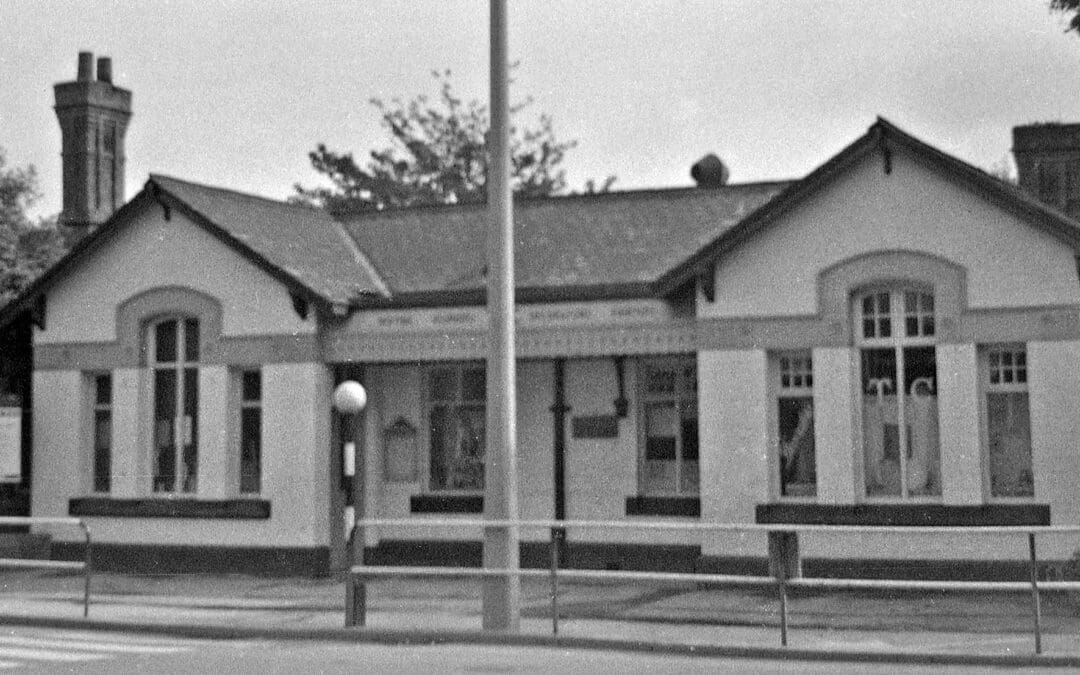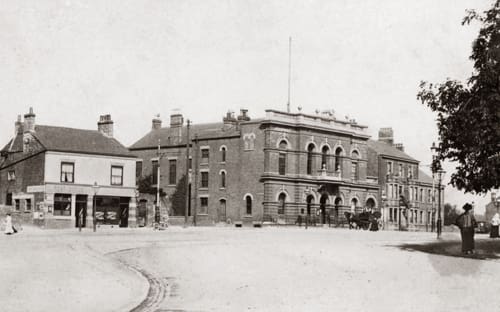Ilkeston: Ball’s Factory — Burr Lane Grade 2: SK 466422
Four storey brick built hosiery/lace factory built c. 1845 but in a Georgian style for Francis Ball and Sons. Red Brick with cast iron windows and a distinctive central pediment and clock. It is the earliest substantial factory in the town and remains in the ownership of descendants of the Ball family. Queen Victoria was among the customers who bought gloves from Ball’s factory.
Ilkeston: Charnos — Corporation Road SK 474401
Charnos Hosiery Ltd, founded by Charles Noskwith, came to Hallam Fields in 1936 and expanded rapidly. The original building was standing until recently and was a good example of 1930s industrial architecture.
The site is now occupied by housing.
Ilkeston: The Electric Power Station Grade 2: SK 455423
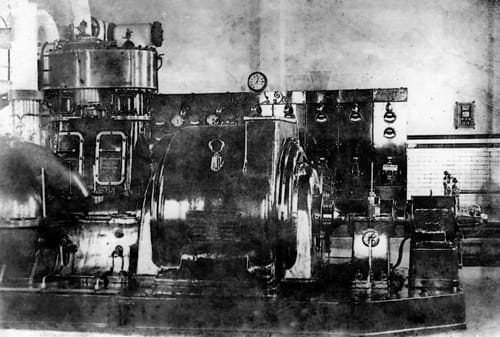
Built in 1902 by the Derbyshire and Nottinghamshire Electric Power Company to supply electricity for lighting the town and to power the street tramway system in the area known as ‘Manor Floods’.
This building has now been demolished.
Ilkeston: The Gas Works — Rutland Street SK 467425
An ornate three storey brick building with much decorative brickwork on the north side of Rutland Street, believed to be the retort house of 1901-10.
This building has now been demolished.
Ilkeston: Erewash Canal
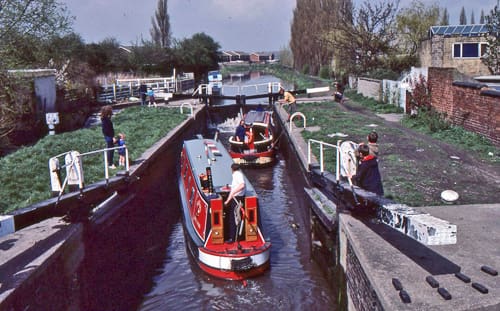
Running on the east side of the borough, close to the county boundary from Langley Mill to the Trent at Long Eaton. Opened in 1779, it was built to provide transport for Derbyshire coal to markets in Loughborough and Leicester. The engineer was John Varley. At the canal’s junction with the Derby Canal is the Sandiacre Lock Cottage with its attached pentagonal single storey toll booth. This building is now the headquarters of the Erewash Canal Preservation and Development Association.
The original hump-back bridges and locks are Grade 2 listed.
Ilkeston: Hoffman Kiln — Oakwell Brickworks Grade 2: SK 460412
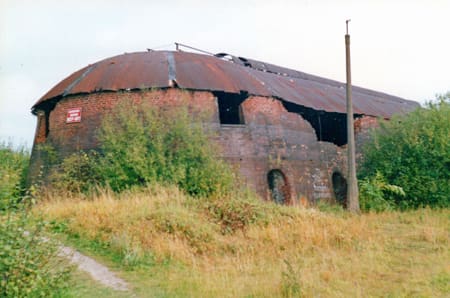
The Hoffman brick kiln is the most substantial remnant of the former Oakwell Brickworks and is one of five examples of this type in the country. Although the kiln is listed, it has collapsed in places.
Ilkeston: The Nutbrook Canal
Sections of the former Nutbrook Canal (opened 1796) are still in existence and stone and brick remains of former locks can be seen. The canal was built to carry coal from the Shipley collieries to the Erewash Canal at Stanton. The canal was surveyed by William Jessop and the engineer was Benjamin Outram.
Most of the waterway was abandoned for transport use by 1950, but proved a viable source of water for cooling on the Stanton Ironworks site.
Ilkeston: Sudbury’s Factory (Rutland Garments) — Market Street SK 464416
A substantial late 19th century three storey brick built hosiery factory on the east side of Market Street, erected for C and F Sudbury and later used by Rutland Garments. The two storey building to the rear may be of an earlier date.
The building has now been converted into residential flats.
Ilkeston: The Weleda Building — Heanor Road

Originally built and designed by George Neames in 1939 for Michael House (a Rudolf Steiner school).The distinctive architectural style was designed to avoid the the use of right angles, one of Steiner’s architectural principles.
Ilkeston: Wheelwrights’ Furnace — Gladstone Street SK 466415
Furnace complete with chimney, formerly used by wheelwrights to heat iron tyres before fitting to wheels.
Kirk Hallam: The Beauty Spot SK 462405
The drinking water for Ilkeston was supplied from a reservoir here until the early 20th century. It was fed from the Oakwell stream, also pumped from a shaft of the Kirk Hallam Colliery and supplemented by water from the Nutbrook. It later became a recreational area with boating and sporting activities, waterside walks, band concerts and firework displays.
Little Hallam: Hallam Mills — Birdcroft Lane SK 467405
A lace factory built in 1907 for George Maltby and used by him until the late 1920s. A single storey office building fronts at Little Hallam Lane with typical single storey brick built factory at the rear having north light roof. Later used by the hosiery manufacturer Cox Moore Ltd. The building was demolished in the 2010’s and replaced by modern housing.
Stanley: Footrill Colliery SK 410395
Brick buildings marking the site of the former Derby Kilburn Colliery Company’s Stanley Footrill Colliery. A surface haulage system (rope haulage tramway) delivered coal from the colliery to a wharf just north of Nottingham Road, Derby during the 19th century.
Stanley: Stanley Quarry SK 416398
The whitish sandstone from this quarry was used over many years by locals to whiten their doorsteps. In the 1920s Thomas Anthony discovered that it had excellent qualities as a rubbing stone for preparing surfaces for polishing woodwork. The shale Excelsior Rubbing Stone Company flourished by exporting its products all over the world. With the invention of a mechanical polishing machine, the quarry had to find new markets and manufacture of the Stanley Building Block began. This was an artificial stone block measuring 18″ by 9″ by 9″. Mr Anthony went into partnership and built thousands of houses and bungalows mainly in Chaddesden, Cherry Tree Hill and Allenton. There are several examples in Stanley itself. The business went into liquidation at the time of the Second World War and the quarry was largely filled in by landfill in 1961.
Stanton By Dale (New Stanton) : The Stanton Ironworks
The site of the much reduced ironworks on both sides of Lows Lane. There had been ironworking on the site since the 1840s but much is now derelict and little of any antiquity remains. There are a few 19th century foundries and workshops remaining but no trace of the blast furnaces. Still intact are the ornate company offices of 1914, adjacent to Lows Lane and a number of other 20th century associated buildings. See also A Brief History of Stanton Ironworks
West Hallam: The Bottle Kiln Grade 2: SK 434421
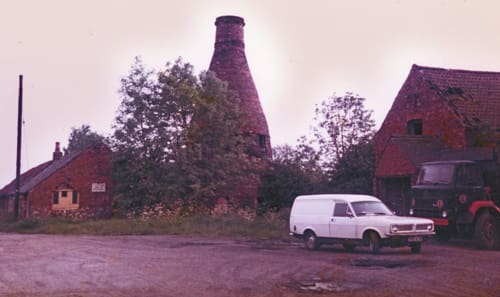
On the site of an earlier coal pit and later brick yard on High Lane, in 1922 this became the Peak Pottery of the West Hallam Art and Earthenware Company Ltd. Teapots, vases and dishes were among the products of the two kilns until the 1940s.
The surviving kiln is now incorporated into a craft centre, shop and restaurant. Examples of West Hallam pottery can be seen displayed at Erewash Museum.


